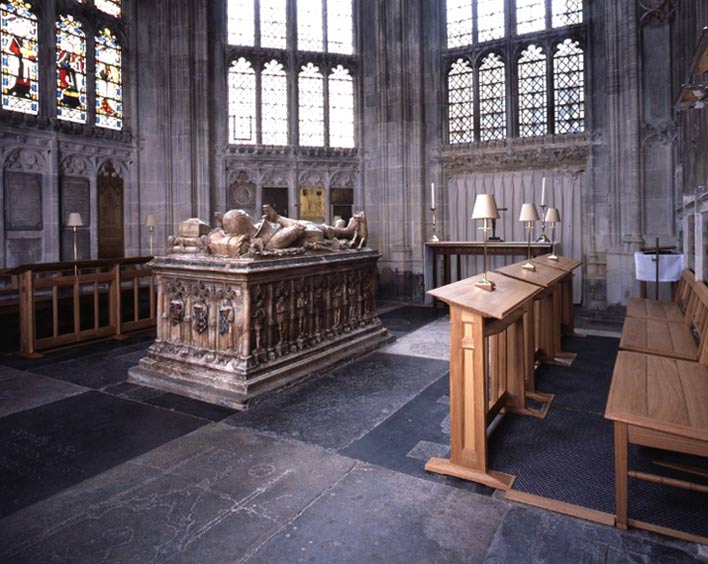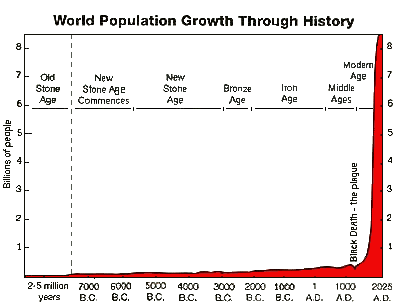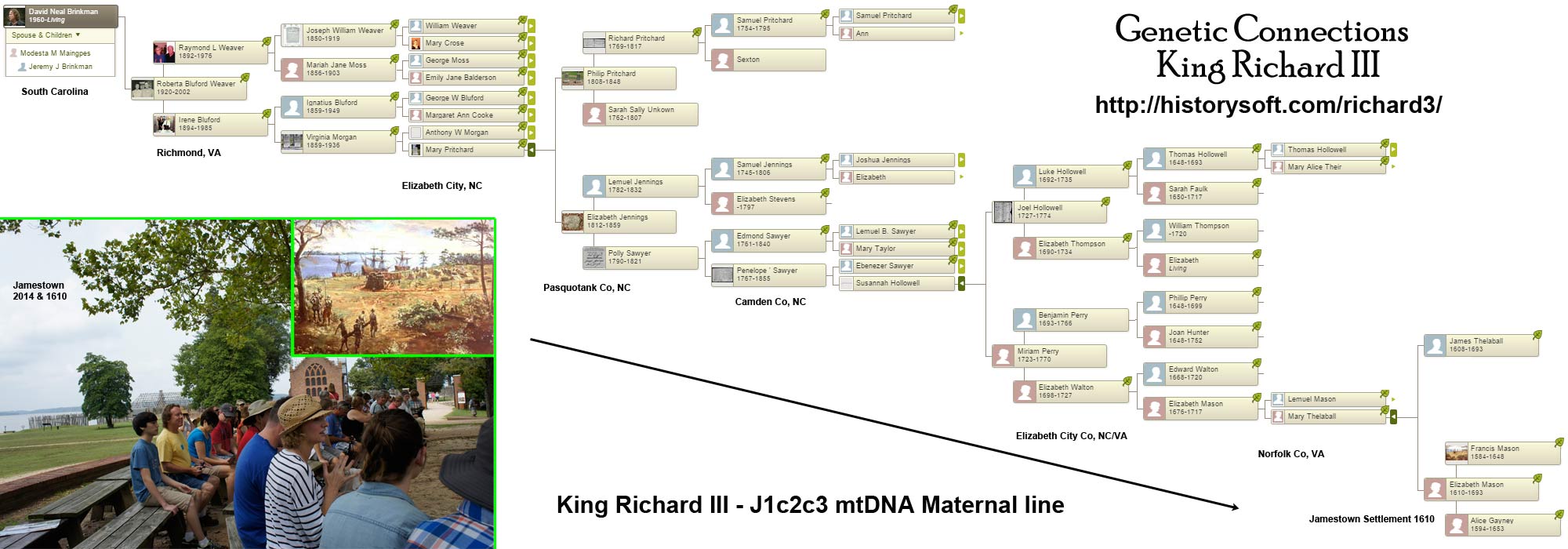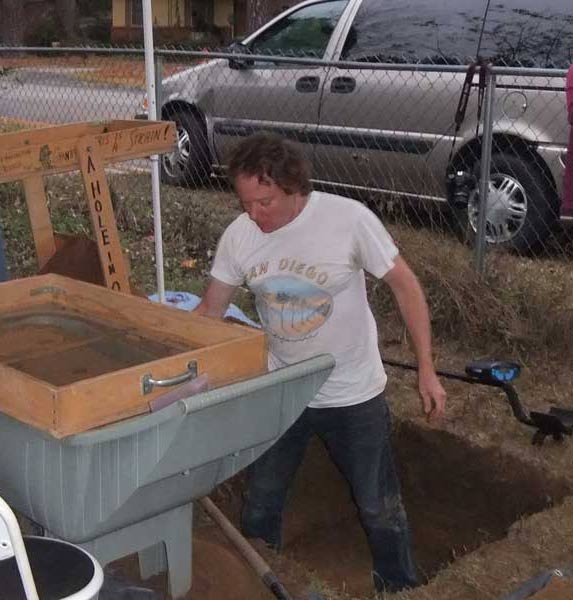Connecting to Richard III

June 9, 2017: The project was presented to the Greater Piedmont Chapter of the Explorers Club. View this presentation "A King's Match in America: King Richard III and the emerging true ancestry of America." at this link.
May 4, 2017 Update: We
now have 13 full mtDNA
sequence matches (J1c2c3) with Richard III through FTDNA. 12 of these
people
are engaged in our project and we are trying to contact the other
match. We
also have 4 J1c2c matches on 23andme whose raw mtDNA data have been
verified to
have the additional J1c2c3 mutation. These 4 people are also engaged in
the project.
That brings the total tested number of J1c2c3’s to 17 in the United
States. The
only other known matches in the world are the 2 that were involved in
the
original Ashdown-Hill work (Wendy Duldig and Michael Ibsen).
12 of the
American matches have autosomal DNA data loaded on Gedmatch.com and 4
of these
are also on AncestryDNA. Most of the last year has been spent analyzing
autosomal matches between these people to determine their relationship
to each
other. A significant amount of time has been spent building and
verifying our
genealogy. In the DNB lineage, we have autosomal matches proving a 7th
great-grandmother. Three genealogy lines have been considered going
back from
her and they all lead into the heart of the Plantagenet family but
none, as of
yet, link to the known J1c2c3 line of the King. A recent autosomal
match on
AncestryDNA may be proof of an 8th great-grandmother and genealogy has
been
taken back another 7 generations into, again, the heart of the
Plantagenet
family. More work is now being done to take this back further. Our full
sequence mtDNA and genealogy has been provided to the lead
DNA/genealogy
researchers of Richard III (Dr. Turi King and Dr. Kevin Schurer). A
scientific
paper on our work is about to be published. Our goal is to take the
American
genealogy maternal line back to the J1c2c3 sister, mother, grandmother,
or a
great grandmother of Richard III.
February 15, 2015 Update: Based on new autosomal DNA tests on Brinkman, we now have DNA evidence that may confirm the genealogy back to Elizabeth Mason (1676-1717). This would also tie us into a well known line that takes us back to Alice Gayney who came from England to the Jamestown settlement in 1623.
January 3, 2015 Update: The full sequence mtDNA results (released in December 2014) show King Richard III to have the same additional mutation as David Brinkman making them an exact mtDNA match. Only five people are known to have this match but that is expected to change soon as we have begun taking DNA samples from other people identified in David Brinkman's maternal family tree lines. The Family Research Society of Northeastern North Carolina is now helping us and this has led to our maternal line extending three more (maybe four) generations back to the year 1700.
If you thought you might be related to a famous person from the past, what would you do about it? This project attempts to take the rare DNA haplogroup of King Richard III and link modern day families to Richard's Plantagenet family using DNA and Genealogy. The over 500 year old bones of King Richard III were recently found in Leicester, England. The evidence found in the grave, and the DNA analysis (completed on the bones), proved "beyond reasonable doubt" that this was the King.
So why would King Richard III be of interest to David Brinkman? David was born in Myrtle Beach, South Carolina and (until recently) his only known link to England was a 4th great grandmother born in 1788 in the mostly English settlement of Elizabeth City, North Carolina. Brinkman is currently involved in a research and archaeological dig to find the lost colonial village of Granby (near Columbia, South Carolina) which was named after the Englishman John Manners. In the late 18th century, Manners would hold the title of the Marquis of Granby. Certainly, there could not be a connection between Manners and King Richard III.. or could there be?
Back in about 2009, just for kicks, Brinkman tried a paternal DNA test that was advertised by a popular genealogy service. It simply told him that he was in the haplogroup "R1B". 80% of all Europeans are "R1B". That didn't tell him much. Earlier this year (summer 2013), Brinkman started hearing some good things about another DNA service and figured, with all the advancements in the last few years, he would give the DNA ancestry another try. This time, the paternal group came back as a R1b1b2a1a2d3*. This took him from 80% of the European population down to a single digit percentage. The service also included a maternal test. It came back as J1c2c and later refined to J1c2c3. It didn't sound like much until he started researching it. This was the maternal haplogroup of King Richard III. Initially, the wide range of scientists that identified his remains, had put Richard III in the broader group of "J1" which accounts for about 2% of the European population. It would later be taken to the sub-group of "J1c2c" which is less than 1% and maybe more like 1 in 10,000. Brinkman realized the opportunity. Update: The final full sequence of the King and David found an addition rare mutation which takes the haplogroup to J1c2c3. At the time these new results came, only 5 people were known to be in this group.
Having recently worked on two extensive historical/archaeological projects, he knew that scientific evidence and archival evidence must come together to solve a case like this. He was just handed the scientific evidence (his own DNA) and he only needed to complete the archival work. Given the usually complete documentation of Royal families, maybe he just needed to connect a few missing links between his known family tree and the ancestors of the King's Plantagenet family. It would be a challenge tracing the maternal line through a name change in every generation but Brinkman knew there could be many others like himself, with the matching J1c2c, and their own family trees.
There were still some things to learn about the DNA match and the probability of linking to a member of King Richard's immediate family or to a very distant relative from hundreds, maybe thousands of years, before Richard. For Brinkman, that was the most important thing to assess because, it would be impossible to take his family tree back thousands of years.
So, how does this maternal DNA work?
Mitochondrial DNA (mtDNA) is inherited solely from the mother. It never changes from one generation to another except for an occasional mutation which may happen about every 10,000 years. mtDNA has nothing to do with your make-up. A mutation in it will not affect the way you look, how long you live, or how well you can reproduce. What it does do is to give us a maternal trace into the past. As you will see later, we got very lucky with a mutation in J1c2c which happened only 4,500 years ago.
What is the probability of connecting to the well documented Plantagenet family?
The timing of the most recent mutation makes this probabilitiy over 99%. If you are J1c2c, you can assume you are a descendant of the Plantagenet family. How is that?
Brinkman's Theory: J1c2c = +99% Plantagenet
Between 4,500 years ago, until the end of the Plantagenet's last King (Richard III), the world's population growth was linear and less than 1/10 of one percent. Over a period of 4000 years, this growth rate led to the population increasing from 25 million to 425 million. That is a big increase in the absolute population number because the starting number (25 million) is, in itself, also large. When the initial population is small, however, the absolute increase is also small. If you apply the same growth rate to the first J1c2c mutation (4,500 years ago) until just 500 years ago, that one mutation only grows into 17 people. This is based on the standard population growth formula of P=Po*e^(rt). An example of a population growth calculator can be found here.So, after the lucky break of having a recent mutation (which has only been able to grow to 17 people in the world over 4000 years) we now get lucky again when a woman, from this group of 17 mutations, marries into the Plantagenet family. The Plantagenets were some of the richest people in the world. Compared to average people of the time, they ate better, had better care, lived longer, and reproduced more. In the Royal family, having lots of babies is very important and the Plantagenets did it very well. Below is a 6 generation maternal segment of the Plantagenet family. Kings Edward IV and Richard III were born in this segment. In less than 200 years, these generations of mothers would lead to the mutation being passed to 2184 Plantagenets. Based on that same continuation of a tiny population increase over the rest of the world, there would have been only 20 others outside of the Plantagenets with the J1c2c mutation. At this point in time (the year 1530), the Plantagenets would now have 99.1% of all J1c2c instances in the world. This percentage would have continued to climb for many generations as the maternal family line continued to thrive over the average population. Today, we can assume that over 99.5% of today's J1c2c people are descendants of the Plantagenets. If you are a J1c2c, King Richard III is one of your ancestors.
Below is the maternal line which leads through KingsThe above 7 women had 62 children. That is an average of 9 children per mother. Being very conservative and estimating that only 3 of 9 children go on to produce children, in 6 generations, this produces 2184 people with the J1c2c mutation. During the prior 4000 years (since the first mutation occurred), the regular population has only produced 17-20 people with the mutation (based on the standard population formula). At this point in time (the year 1530) there are 2204 people with the mutation. 99.1% of them are from the Plantagenet family! The Plantagenet family, despite losing the crown with the death of Richard III, continued to prosper for years to come so this percentage would have continued to increase towards 100%. People today that are in the J1c2c group, can safely assume that they are direct descendants of the Plantagenet family and are related to Kings Edward IV and King Richard III and maybe several other Kings.
Edward IV and Richard III
Mother unknown (maybe the first Plantagenet J1c2c3)
|
/ \
/ \
/ \
Catherine de Roet Philippa de Roet (Catherine sister)
Duchess of Lancaster married Geoffrey Chaucer
1348-1403 (7 children) (4 children)
| |
| |
Joan Beaufort Similar growth assumed for Philippa
Countess of Westmorland
1370-1440 (14 children)
|
|
Cecily Neville
Duchess of York
1415-1495 (13 children)
|
|
Anne of York
Duchess of Exeter
1439-1476 (2 children - died in childbirth)
|
|
Anne St Leger
1476-1526 (11 children)
|
|
Catherine Manners
c.1500-? (11 children)
By the way, the above tree shows Anne St Leger, the Niece of Richard III. Anne married George Manners. This is the same Manners family that would later produce the Marquis of Granby. That fact sent chills done Brinkman's spine. Several years ago, when Brinkman started the research to find a lost South Carolina colonial village, was there something in Brinkman's genes that led him to Finding Granby?
Below: About 15 years earlier, the Brinkman family traveled to England and viewed the tomb of Anne St Leger and George Manners in St. George's Chapel, Windsor. David had no idea, at the time, that he was possibly viewing the resting place of his 17th great grandmother who would spawn the name of a lost colonial village which Brinkman and others would find in his Cayce, South Carolina yard in 2012. Just 18 months later, a DNA test would link Brinkman to Anne St Leger, George Manners, and King Richard III. It's a small world.




